
Cassiopeia is a constellation and asterism in the northern sky named after the vain queen Cassiopeia, mother of Andromeda, in Greek mythology, who boasted about her unrivaled beauty. Cassiopeia was one of the 48 constellations listed by the 2nd-century Greek astronomer Ptolemy, and it remains one of the 88 modern constellations today. It is easily recognizable due to its distinctive 'W' shape, formed by five bright stars.

Eta Cassiopeiae is a binary star system in the northern constellation of Cassiopeia. Its binary nature was first discovered by William Herschel in August 1779. Based upon parallax measurements, the distance to this system is 19.42 light-years from the Sun. The two components are designated Eta Cassiopeiae A and B.

Messier 103 is a small open cluster of many faint stars in Cassiopeia. It was discovered on 27 March 1781 by Pierre Méchain, but later added as Charles Messier's last deep-sky object in his catalogue.

The Max Planck Institute for Mathematics is a research institute located in Bonn, Germany. It is named in honor of the German physicist Max Planck and forms part of the Max Planck Society (Max-Planck-Gesellschaft), an association of 84 institutes engaging in fundamental research in the arts and the sciences. The MPIM is the only Max Planck institute specializing in pure mathematics.

Alpha Cassiopeiae or α Cassiopeiae, also named Schedar, is a second-magnitude star in the northern constellation of Cassiopeia. Though listed as the "alpha star" by Johann Bayer, α Cas's visual brightness closely matches the 'beta' (β) star in the constellation and it may appear marginally brighter or dimmer, depending on which passband is used. However, recent calculations from NASA's WISE telescope confirm that α Cas is the brightest in Cassiopeia, with an apparent magnitude of 2.240. Its absolute magnitude is 18 times greater than β Cas, and it is located over four times farther away from the Sun.

Honores Friderici or Frederici Honores, also called Gloria Frederica or Frederici was a constellation created by Johann Bode in 1787 to honor Frederick the Great, the king of Prussia who had died in the previous year. It was between the constellations of Cepheus, Andromeda, Cassiopeia and Cygnus. Its most important stars were Iota, Kappa, Lambda, Omicron, and Psi Andromedae. The constellation is no longer in use.

The Cassiopeia is a luxury cruise train service in Japan, operated by East Japan Railway Company. It formerly operated as a limited express from July 1999 until March 2016, when it was discontinued due to the opening of the Hokkaido Shinkansen. It ran between Ueno Station in Tokyo and the city of Sapporo in the northern island of Hokkaido. The one-way journey to Sapporo took approximately 161⁄2 hours.

Cassiopeia A (Cas A) is a supernova remnant (SNR) in the constellation Cassiopeia and the brightest extrasolar radio source in the sky at frequencies above 1 GHz. The supernova occurred approximately 11,000 light-years (3.4 kpc) away within the Milky Way; given the width of the Orion Arm, it lies in the next-nearest arm outwards, the Perseus Arm, about 30 degrees from the Galactic anticenter. The expanding cloud of material left over from the supernova now appears approximately 10 light-years (3 pc) across from Earth's perspective. It has been seen in wavelengths of visible light with amateur telescopes down to 234 mm (9.25 in) with filters.

50 Cassiopeiae is a white star in the northern constellation of Cassiopeia. In the past, it had been misidentified as a suspected nebula, and given the number NGC 771. The star is visible to the naked eye, having an apparent visual magnitude of +3.95. Based upon an annual parallax shift of 20.76 mas, it is located 157 light years away. It is moving closer, having a heliocentric radial velocity of −18 km/s, and will approach to within 82 ly in 1.879 million years.
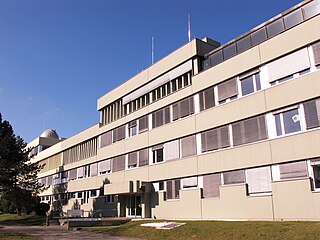
The Max Planck Institute for Radio Astronomy (MPIfRA) (German: Max-Planck-Institut für Radioastronomie) is located in Bonn, Germany. It is one of 80 institutes in the Max Planck Society (German: Max-Planck-Gesellschaft). 50°43′47.6″N7°4′9.2″E

Tomakomai Station is a railway station in Tomakomai, Hokkaido, Japan, operated by the Hokkaido Railway Company.

NGC 189 is an open cluster in the Cassiopeia constellation. It was discovered by Caroline Herschel on 27 September 1783, and independently rediscovered by John Herschel on 27 October 1829.
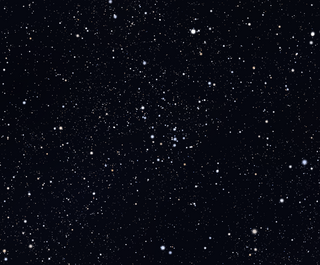
Trumpler 3 is an open cluster located in the constellation Cassiopeia. It has the visual magnitude of 7 and is one of the most famous star clusters in the Trumpler catalogue.
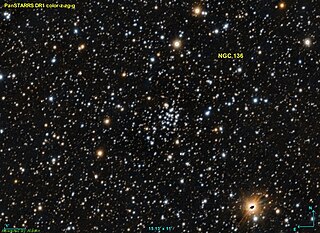
NGC 136 is an open cluster in the constellation Cassiopeia. It was discovered by William Herschel on November 26, 1788.

NGC 366 is an open cluster located in the constellation Cassiopeia. It was discovered on October 27, 1829, by John Herschel. It was described by Dreyer as a "cluster, small."
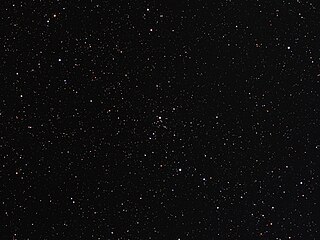
NGC 433 is an open cluster in the northern constellation of Cassiopeia, located at a distance of 6,500 light years from the Sun. It was discovered on September 29, 1829, by John Herschel, and was described by John Dreyer as "cluster, small, a little compressed." The cluster is considered on the poor side, with only 12 stars above magnitude 16. It has a linear diameter of 26.3 ly, with around 479 times the mass of the Sun and an age of 65 million years.
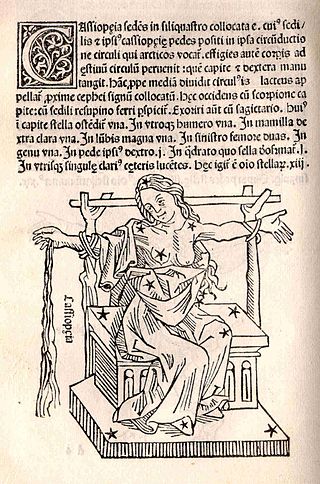
Cassiopeia or Cassiepeia, a figure in Greek mythology, was Queen of Aethiopia and wife of King Cepheus of Ethiopia. She was arrogant and vain, characteristics that led to her downfall.
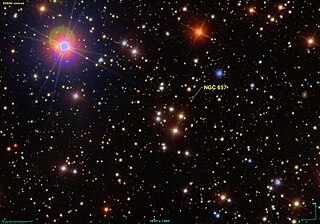
NGC 657 is an open cluster containing very few stars or a group of stars located in the constellation Cassiopeia. It was discovered by British astronomer John Herschel in 1831.

Markarian 50 is a young open cluster in the Milky Way galaxy. Located at about 3,460 pc away in the constellation Cassiopeia, its age is estimated at only about 7.5 million years old. Markarian 50 may be a member of the OB association Cassiopeia OB2. The Wolf-Rayet star WR 157 is a member of Markarian 50.

















